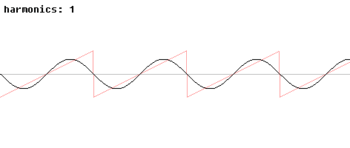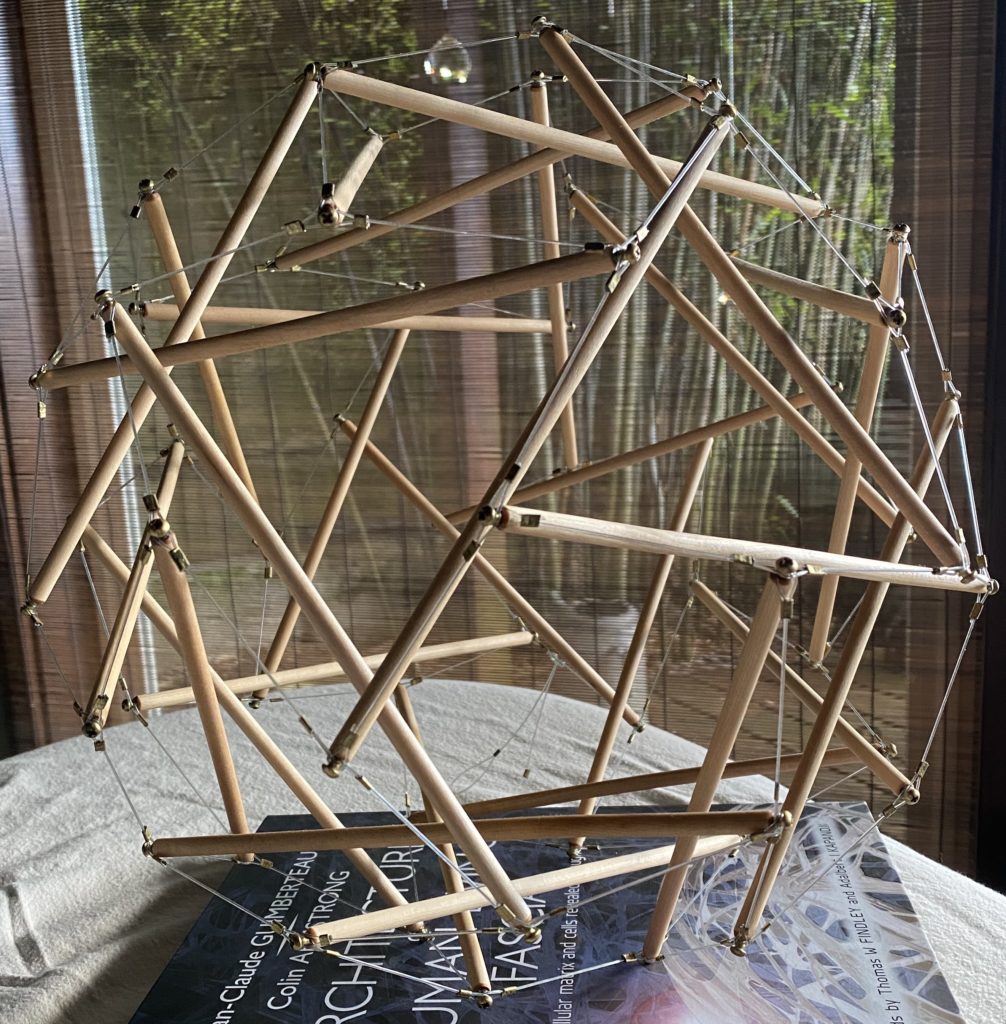TENSEGRITY
Tensegrity, a portmanteau of “tensional integrity,” is a structural principle that has found significant applications in biological systems. At its core, tensegrity structures are composed of components under pure compression (typically rods or struts) and pure tension (such as cables or tendons), which are pre-stressed allowing the structure to sustain its shape and stability. In biology, this concept is manifested at various scales, from the molecular to the cellular, and up to the anatomical level, exhibiting fractal self-similarity at all levels. For instance, at the cellular level, the cytoskeleton – a complex network of microfilaments, intermediate filaments, and microtubules – demonstrates tensegrity by maintaining cell shape, providing mechanical resistance against deformation, and facilitating intracellular transport and signaling. At a larger scale, the musculoskeletal system exemplifies tensegrity in how muscles, bones, and connective tissues work together to create a stable yet dynamic framework that supports movement and posture in living organisms. Applying the principles of tensegrity to biological systems offers insights into biomechanics, cellular mechanics, and the development of bio-inspired materials and structures in engineering and architecture. The sculptor, Kenneth Snelson, was a prolific explorer of Tensegrity.
The study of Tensegrity as a model for biological systems has been a powerful tool for this writer. He was first introduced to it in the 1970s by Joseph Heller, the founder of Hellerwork, who drew upon the work of R. Buckminster Fuller and Kevin Snelson. Steven Levin later popularized this area of study in the early 2000s. While Tensegrity offers insightful perspectives, it is inherently a static model, primarily suited to architecture and sculpture. This is due to its focus on position. Since animals are living entities characterized by movement, Tensegrity is most useful for studying animal locomotion in the context of a “snapshot” of a movement pattern. My research extends beyond this, exploring the application of Tensegrity in movement – specifically, its second and third-order functions of position.
TENSEGRITY IN MOVEMENT
The easy availability of affordable Inertial Measurement Units (IMUs) has made the study of tensegrity in movement possible for a student of physiology1. From this work, it is proposed that Tensegrity expression in animals, particularly mammals, for a given unit of work:
in the Time Domain:
For a given unit of work, accelerations of lower magnitude over a longer duration better embody Tensegrity principles more effectively or said differently, are inversely related to the magnitude of the third-order function of position – which is called Jerk. The less Jerk in a movement for a unit of work, the more integrated the Tensegrity mechanics.
in the Frequency Domain:
For a given unit of work, is related to the power spectrum in the lower frequencies (~<3Hz). The greater the Tensegrity, the greater the power spectra low-frequency to high-frequency ratio. This can also be described as the ratio of the power within the fundamental frequency to the harmonics. This can be teased out by analyzing the rate of change values (Jerk):
Witin a Movement, the Higher the Median Frequency of the Power Spectra
This means more energy in the lower frequencies
of Jerk in the Vertical Axis,
the Greater the Tensegrity Dynamics

of the fundamental frequency to the harmonics
This concept views the connective (soft) tissue matrix as a key player in maintaining the energy within a movement, balancing between compressional and tensional end-stops without surpassing the tissue’s adaptive capacity. Once these end-stops are exceeded, cellular mechanisms3 initiate to clean up and rebuild the matrix, often with a denser, stronger collagen. While reinforcing the tissue, this process also compromises its flexibility and suppleness thereby reducing flexibility.
Independent nodes within this network often coalesce into dense clusters, manifesting as soft tissue adhesions, which are easily palpated. These adhesions may be challenged by extending movement scope and as well as through through Manual Therapy2.
The inference for our health is that the higher the median frequency of the energy on movement (the greater the low-frequency component), the more information is available for the creation and recreation of our bodies3. This study of dynamic tensegrity in biological systems (movement) seems to want a unique identifier…
This concept can be observed by comparing animal and urban human gait patterns. The shock absorption and energy conservation mechanics in animal gait patterns are nearly universal. If these patterns are studied for some time the foundational differences become apparent.
COINING KINSEGRITY:
“Kinsegrity” is a term that effectively captures the essence of both kinetic (movement) and tensegrity (structural balance). It neatly blends these concepts into a single, cohesive word. The term suggests a structure or system that is not only stable and balanced but also capable of fluid and dynamic movement. It’s catchy, memorable, and conveys the intended meaning, making it a great choice for describing systems or structures that exhibit dynamic tensegrity4.
APPLICATIONS
From the above premises, it becomes a relatively simple matter to comparatively analyze Tensegrity biomechanics dynamically in movement using IMUs. It is known, but not studied here that this can also be done with AI gait video analysis. There are two examples below where these sensors are being applied:
Self Help:
The iPhone Sprike App is a gait training feedback tool using the rate of change of acceleration (Jerk) or more accurately the absence of Jerk (Sprike) to help navigate to better-optimized gait patterns. It offers immediate feedback on gait dynamics making it a powerful training tool, utilizing sensors embedded within the phone.
Research Study:
There is also an ongoing study evaluating a hypothesis that improvement of resilience in movement is a metric for the efficacy of therapeutic interventions. This study compares the relative Jerk and frequency power spectrum of a snapshot of the client walking before and after therapy:
MANUAL THERAPY STUDY
- This study is an example of using acceleration data to evaluate gait dynamics:
A COMPREHENSIVE DESCRIPTION OF GAIT - A brief study of these kinetic attributes of Tensegrity is found here:
A METRIC FOR STUDYING TENSEGRITY IN ANIMAL PHYSIOLOGY - The supporting science for the statement that stress/strain is sensed as information at the cellular level:
MECHANOTRANSDUCTION FOR FIBROBLASTS AND OSTEOBLASTS - Kinsegrity is conceptually similar to the rather dull-sounding “Mechanobiology” coined by Donald Ingber and discussed in many of his papers:
INGBER MECHANOBIOLOGY – GOOGLE SCHOLAR

